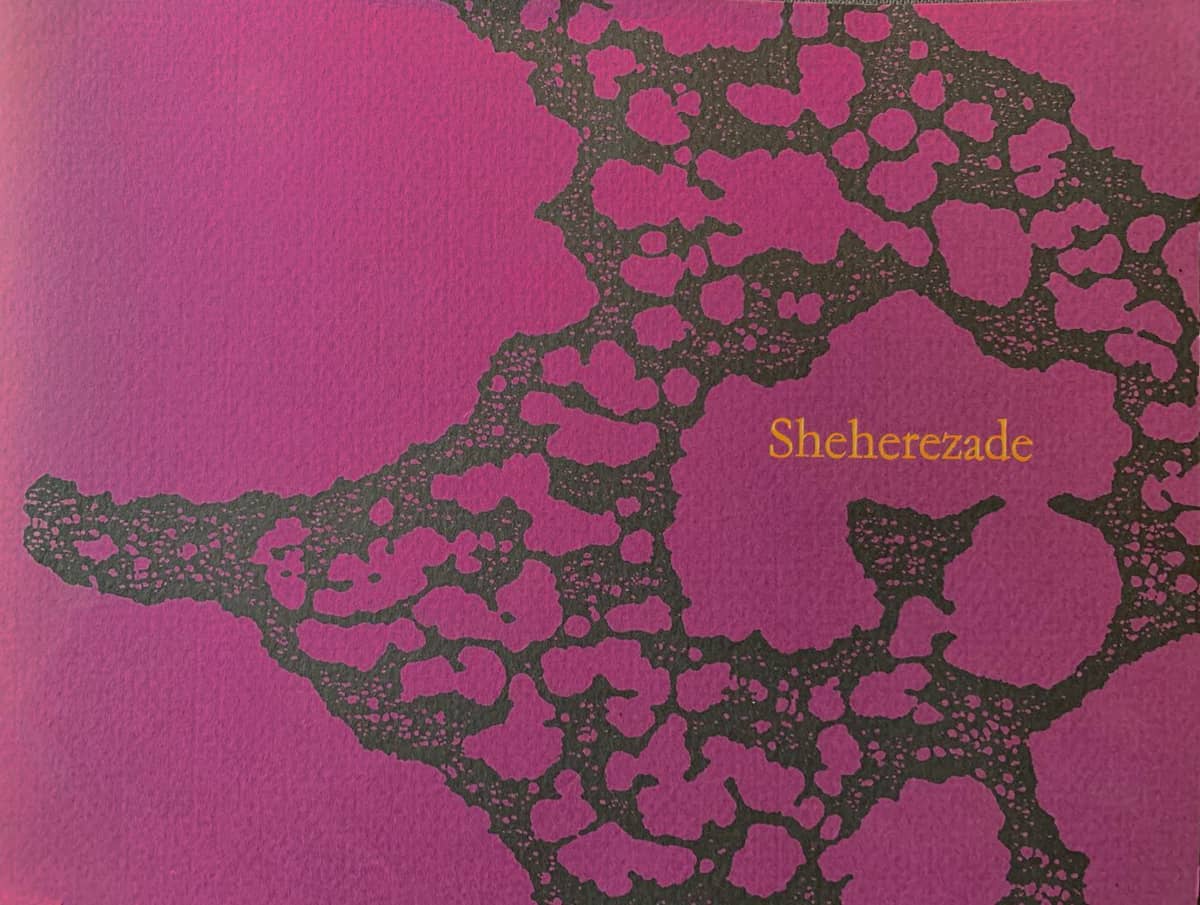“From the Classroom” is a series that features some of the great work and research from students who visit our collections. Below is a blog by Leslie Hankins from Dr. Jennifer Burek Pierce’s class “History of Readers and Reading” (SLIS:5600:0EXW)
By Leslie Hankins
The bold imperial purple cover with the title, Sheherezade embossed in gold catches our attention; next, a cryptic graphic raises questions and disorients the viewer. What is this? A close up of fabric? a landscape? a detail from a scientific slide? Awash with questions, we open the book; the deceptively simple title page identifies the book as “a flip book by Janet Zweig with text by Holly Anderson.”
It is an Artists’ book, though paperback and perfect bound. As we begin to turn the pages, we are alerted that something odd is going on as we are drawn in to zoom in to the words of Sheherezade until the letters seem to become a maze of shapes and forms viewed through the loupe or magnifying class of a conscientious letterpress perfectionist. We are hooked. Sheherezade: a flip book by Janet Zweig with text by Holly Anderson flips our conceptions of the flip book and the artists book. In this book, the flip on the left-hand page reveals a small figure of a woman in vintage apparel removing her outer garment; this scene is repeated every 30 pages or so. That is the more traditional flip book dynamic, perhaps making a sly dig at the striptease staple of salacious flip books.
Meanwhile, the right-hand side of the text has another, more intriguing reveal. When we flip that side, we operate as a camera zoom, moving into the text, quite literally, gliding closer and closer into the letters, and into new texts that are revealed within openings in the type itself. This exploratory reveal is repeated with new texts. As we move through the text it becomes a distorted landscape in the exaggerated close up. It is as if we were one of those mini-cameras doctors use to do micro-surgery. Quite literally, then, this book takes close reading to the nth degree. As we continue flipping the pages, in the round opening of one of the letters something new begins to emerge: another whole continent-shape of more words, a story in fact, and so we continue the exploration, engaged and agog. The linear cyclical movement of the flip/strip pulls the reader in one direction, while the zoom in lures us in another. The result is a profound sense of disorientation, or vertigo.
This close reading takes the daring approach to abandon the linear, and moves through the text, tunneling or moving in portals through it, in a magical new way of reading. Innovative and mind-boggling. The book exposes and challenges our expectations about reading as a process; it rebels against linear unfolding, and invents a new tunneling-through movement. We are active agents, readers on a mission as we explore through this book, not passive.
Janet Zweig is a multi-media artist; in addition to her dozens of artists’ books, she is most known for her art in the public realm, including large works such as a sentence-generating sculpture for an engineering school in Orlando, and a kinetic installation on a pier on the Sacramento River. Her many grants and awards include a National Endowment for the Arts Visual Arts Fellowship, Sculpture, 1994 and the Orchid Award from the San Diego Architectural Foundation for Climate Clocks (Abstraction Devices), 2019.
Further Reading
The best introduction to Artists’ Books is to see examples, in UI Libraries Special Collection, on-line, or in book form:
Salamony, Sandra with Peter and Donna Thomas. 1000 Artists’ Books: Exploring the Book as Art. Quarry Books, 2012.
The Smithsonian’s blog of artists’ books
The University of Iowa webpage defines the elusive term artists’ book
For theoretical and analytical conceptualizing of the Artists’ Book:
Drucker, Johanna. The Century of Artists’ Books. New York City: Granary Books, 1995.
Drucker, Johanna. The Visible Word: Experimental Typography and Modern Art, 1909-1923. Chicago: University of Chicago Press, 1994.
Rothenberg, Jerome and Steven Clay, eds. A Book of the Book: Some Works and Projections about the Book and Writing. New York: Granary Books, 2000.
Smith, Keith. Structure of the Visual Book. Book 95. Third Edition. Keith A. Smith Books, 1994.
